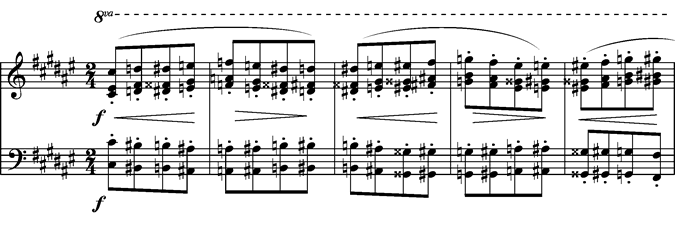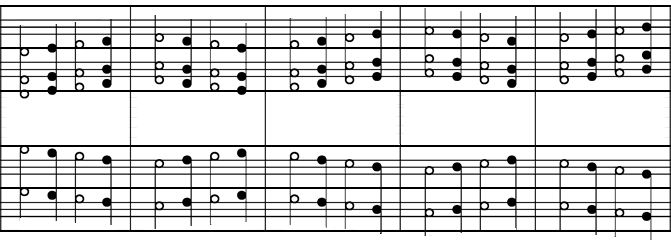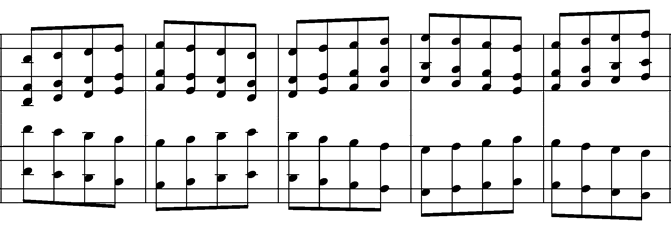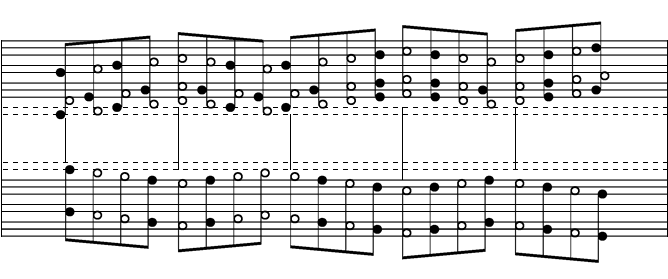This tutorial focuses on the difficulties related to key signatures and accidentals in traditional notation. Let’s look at an excerpt from Franz Liszt’s “Hungarian Rhapsody 2.” This passage is in F# Major, one of the more difficult key signatures, and also entails the use of many accidentals.

An excerpt from Franz Liszt’s “Hungarian Rhapsody 2”
If a picture is worth a thousand words, then this example certainly speaks for itself. For someone not already well-trained in traditional notation it is a difficult passage to read with its many accidentals combined with a difficult key signature.
(Actually, experienced readers of traditional notation may not find this passage to be that difficult for reasons that will become apparent below. Nevertheless, consider how daunting it is for a beginner and how much training it takes for it to no longer seem so difficult.)
There are also many other articulation marks vying for the musician’s attention. Just deciphering the pitch of the notes takes effort and attention that could be paid to the other articulation marks. This illustrates the general point that the difficulties of traditional notation take time and effort that could be better spent on other things such as musicality, expression, or technique. However, for the purposes of this tutorial, we have removed these other articulation marks from subsequent images so we can better focus on the accidentals and key signature.
As many musicians have had to do with such passages, we can also “write in” the accidentals that are specified by the key signature to make it easier to remember to play them. These are “written in” in blue in the next image:

Even stripped down to just the basics of notes and accidentals the passage is still quite challenging for a beginner to read. Almost every note is modified by the key signature or an accidental sign. But is the music really as difficult as it appears?
Listen to the audio clip and notice how the notes actually move in a fairly simple and straightforward manner, always moving by semitone intervals up and down the chromatic scale. The music is actually much simpler than it looks in traditional notation.
Let’s see how much clearer this passage appears in some notations with a chromatic staff. First let’s take 6-6 Tetragram notation by Richard Parncutt:

With a chromatic staff notation, each note has its own unique place on the staff so there is no need to refer to accidentals or a key signature to determine the pitch of the notes.
Now it becomes clear that the music itself is not nearly as complicated as it first appeared. We can see that it is a fairly straightforward chromatic progression of the same chords and intervals. The bass or left hand part is a series of octaves. Notice how the notes an octave apart have the same appearance on the staff. Similarly, in the treble or right hand part we can see a series of chords all consisting of an octave and a major third.
These basic advantages of a chromatic staff are present in the following examples as well. Next, let’s take a look at (an approximation of) Isomorph notation by Tadeusz Wójcik:

You may have noticed that in 6-6 Tetragram notation (above) the notes of this chromatic progression alternated between lines and spaces. Here in Isomorph they alternate between solid/black noteheads and hollow/white noteheads. This makes it even clearer that the notes are ascending or descending in semitone (half-step) intervals. This feature of these two notations is a result of their both having a 6-6 pitch pattern — found in the line pattern of 6-6 Tetragram, and in the noteheads of Isomorph.
Isomorph shares several similarities with Klavar notation. The notes fall on opposite sides of the stems depending on whether they are black or white. Also, it uses a proportional rhythmic notation, so the beams used with the eighth notes in traditional notation are optional. Next, let’s take a look at (a close approximation of) Panot notation by George Skapski:

And (a close approximation of) the Untitled notation by Johannes Beyreuther:

These notations share the same line pattern, and are visually less dense or “busy” than the notations above. Like Isomorph, Beyreuther’s notation also has a 6-6 pattern in its notehead color that makes it easy to see the music ascending and descending by semitones. Next, let’s look at Twinline notation by Thomas Reed:

Twinline also has a 6-6 pitch pattern that is present in its notehead shapes, so you can see the notes alternating from triangles to ovals indicating semitone (half-step) intervals. The use of two notehead shapes allows the Twinline staff to take up less vertical space. Next, let’s look at some chromatic notations that have a 7-5 pitch pattern, starting with Klavar, Mirck Version by Jean de Buur:

Klavar has a 7-5 pitch pattern in its noteheads and line pattern. This means that all of the notes that are naturals or double sharps in traditional notation are open/white noteheads and appear on spaces on the right side of the stem, and those that are sharps are solid/black and appear on lines on the left side of the stem. In the Mirck version of Klavar, notes appear on the right side of the stem unless they are in a chord that consists of both black and white notes, then they follow the usual Klavar placement.
Klavar uses a proportional rhythmic notation, so the notes are spaced evenly along the horizontal axis and measure lines coincide with the stems of the note on the first beat of each measure. The beams are optional. (Note that standard Klavar is usually oriented vertically and read from the top to the bottom of the page. This illustration of the Mirck version is oriented horizontally instead.) Next let’s look at Express Stave by John Keller:

Express Stave also has a 7-5 pitch pattern in its noteheads. All of the notes that are naturals or double sharps in traditional notation are open/white noteheads, and those that are sharps are solid/black. The staff takes up less vertical space because the notes are not spaced as widely apart on the vertical axis as in most other chromatic staff systems. The black and white noteheads help to distinguish the pitches of notes that are vertically close together.
In sum, traditional notation with its key signatures and accidental signs makes this relatively simple passage of music more difficult than it needs to be. In contrast, chromatic staff notations make it much easier to read, play, and understand. The 6-6 chromatic notations in particular reveal the passage’s interval structure much more clearly. The 7-5 chromatic notations show the white and black notes clearly to the pianist, a tablature-like benefit. These advantages free up the attention of the musician to concentrate on other articulation signs and overall musicality.
Thanks goes to Andre Lippens for pointing out this passage from Liszt’s works. If you know of a difficult passage in traditional notation that you would like to suggest as another instructive example, please contact us.
One may object that since this is basically a chromatic passage of music, a chromatic staff notation will obviously be more suited for it. This is true enough, but it was chosen as a worst-case scenario, a limit case that dramatically illustrates a general principle.